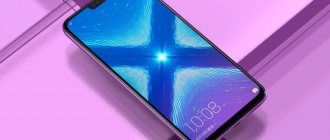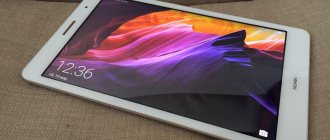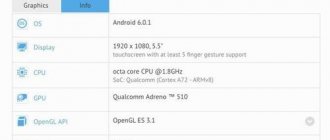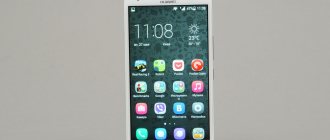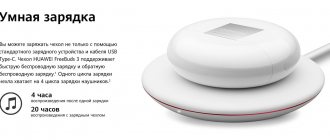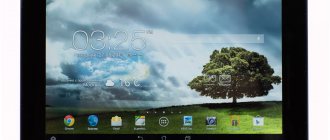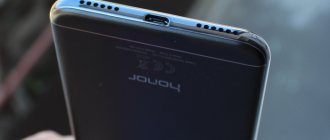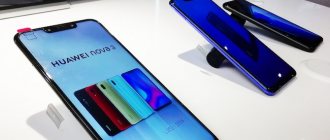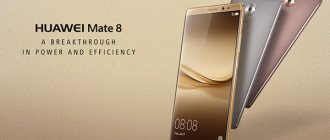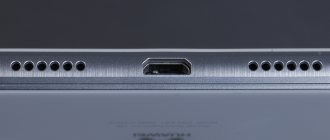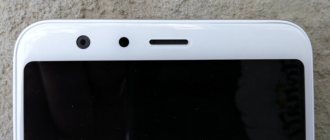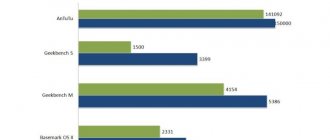Huawei MediaPad T5 10 is an entry-level tablet with a Full HD panel and very powerful hardware. But is it worth the money? You will find out the answer to this question in our review of the MediaPad T5 10.
The Huawei MediaPad T5 10 is a new entry-level budget tablet that offers some pretty cool features, including a Full HD panel, a fast 8-core processor, and a metal back panel. Additionally, it runs Android 8.0 Oreo. Costing from 15,000 rubles, it is relatively inexpensive. But is it a good tablet? Here at HowTablet, we have prepared a Huawei MediaPad T5 10 review to answer all your questions.
Read : Budget tablets 2020 | Android tablets 2019
By the way, MediaPad T5 10 is the successor to last year's Huawei MediaPad T3 10. Compared to the previous version, many things have improved, including internal components and an updated display. Okay, let's get this review started.
| HUAWEI MEDIAPAD T5 10: DESIGN
The design of Huawei MediaPad T5 10 is very similar to that of its predecessor. As with the T3 10, you get a metal back panel. However, above you will find plastic panels for the antennas, while the frame is made of half metal and half plastic. Huawei offers its tablet in two colors – black and champagne.
Granted, it's not the thinnest tablet out there, measuring in at 7.8mm, but it's a fairly thin tablet at this price point. The same applies to the weight of 460 grams. Because of the metal back, it doesn't feel cheap, but it's still not as good as the iPad. Well, the tablet is well built nonetheless.
It charges via a micro USB port, so there are no Type-C ports. Using the adapter, you can connect accessories, including external hard drives. In addition, the MediaPad T5 10 has a headphone jack and a microSD card slot. On the right side are the volume keys and the power button.
User Interface and Operating System
Huawei nova 5T runs on Android 9.0 Pie operating system with EMUI 9.1 user interface. In the new version of EMUI, the phone received a large number of cool animated wallpapers. They remind me of flower petals that sway depending on the position of the phone. Very pretty.
The multitasking menu is displayed with cards of open applications, which you can swipe right or left. This is both convenient and visual, so Huawei decided not to change it, but added the ability to switch to the mode of using two programs in one window.
Among the preinstalled applications there are standard applications for the manufacturer. Fans of a healthy lifestyle can use the “Health” application, which includes an analyzer of your activity, sports activities, nutrition, etc.
You can find some interesting features in the settings. For example, there is a section “Digital Balance”. It analyzes the time spent in certain applications, provides restrictions on phone use, and has several different options for configuration. Thus, you can determine the absolute amount of available time limit for one day. You can also place a temporary limit on any individual application per day or limit its use at night.
There is also such a useful feature as smart traffic saving. Using it, you can deny access to certain programs to the Internet, for example, by assigning their use only via a Wi-Fi network.
| SPEAKERS AND CAMERAS
There are two speakers at the bottom of the tablet. This is not an ideal position for them because you can easily cover it while lying on a bed or couch with the tablet on your stomach. But, in fact, it’s enough just to turn the tablet over and everything is in order. In any case, the sound quality is certainly worthy of attention. This will be useful for watching YouTube videos and listening to music. Yes, the speakers are not the best, but you will have to pay a lot more for the best ones.
While the main camera on the back offers 5 megapixels, the front camera is limited to 2 megapixels. We wouldn't dare call any of these cameras good. Photos and videos look blurry. But we believe that cameras are sufficient for video chats. Again, nothing special.
| HUAWEI MEDIAPAD T5 10: DISPLAY
Compared to the MediaPad T3 10, Huawei has redesigned the screen. Huawei MediaPad T5 10 is equipped with a 10.1-inch screen with a Full HD resolution of 1920 x 1200 pixels. While the pixel density isn't as high as the best tablets of 2020, we don't think Full HD at 10 inches is a bad thing. Yes, if you're very careful, you can make out individual pixels. But if you hold the tablet at a normal distance from you, text and icons will remain clear.
It's an IPS panel with good viewing angles underneath the laminated surface. That is, there are no noticeable voids between the touch screen and the IPS panel. It's also a fairly bright panel, but certainly not the brightest. You can use the tablet outside of your home, but it will be more difficult to read the image in direct sunlight. The contrast is not very good, but the colors look nice.
So overall, we think the MediaPad T5 10's display is pretty good for its price point. The resolution is quite high and other aspects are also good. Sure, you can get better panels, but they will cost you a lot more. By the way, it does not support active styluses.
Huawei MediaPad T5 review: a good tablet with a nice price tag
Score according to GEEK BEARD TV
PROS
- Design
- Good performance
- High quality sound
- Display
- Weight
MINUSES
- Micro-USB
Introduction
At the beginning of September, Huawei introduced an inexpensive tablet with a large screen and good performance, as well as a metal body, high-quality speakers at a reasonable price. Today we will tell you about this device in more detail.
The 10.1-inch screen of the MediaPad T5 is housed in an aluminum alloy body, and on the front there is a protective 2.5D glass with the manufacturer’s logo hidden underneath. The tablet's body is tactilely very pleasant, however, Huawei has always been famous for the quality of the materials used in production. All navigation keys have been moved to the display itself. The frames around the screen are not large, but they are not small either. This has a plus: the tablet is comfortable to hold in your hands.
Almost the entire “back” of the device is made of metal, except for the strips for the antennas that are made of plastic. In the upper right corner there is a peephole of the main camera with a resolution of 5 MP. On the bottom edge there are two speakers with support for Huawei's proprietary Histen technology, which makes the sound rich and voluminous, ensuring high quality playback of your favorite songs. If you do not place the device face down, you can count on high-quality sound and high volume. It is also pleasant to listen to music on headphones, since there is a sound amplifier.
On the left there are headphone and microUSB jacks. On the right are the volume and power buttons.
In terms of ergonomics, the gadget is extremely convenient, but only if you hold it with two hands; it is not suitable for working with one hand - the diagonal is too large. At the same time, the tablet computer looks very elegant. Available colors: black. Dimensions: length - 243 mm, height - 164 mm, thickness - 7.8 mm, weight - 460 g.
As already written earlier, the MediaPad T5 has a 10.1-inch display, but it was not specified that its resolution is 1920x1200 pixels. It is noteworthy that the matrix is an IPS panel with an aspect ratio of 16:10. The screen has excellent viewing angles and good color reproduction, and it also boasts a fairly high level of contrast.
If you are concerned about the health of your eyes, then the tablet has one good feature - an eye protection mode, which significantly reduces eye fatigue by reducing the number of cold colors in favor of warmer ones. This allows you to comfortably read your favorite books and magazines or other electronic text even in the dark. The screen is quite bright and can be used in direct sunlight. There are no problems with image detail here.
Now let's talk about hardware. The processor here uses an eight-core Kirin 659 chip with a maximum clock frequency of 2360 MHz. There are two variations of this tablet: the first is 2 GB of RAM and 16 GB of internal memory, the second is 3 GB of RAM and 32 GB of ROM. If the storage is not enough, it can be easily increased using a Micro SD memory card up to 256 GB.
As for autonomy, everything is in order here: a 5100 mAh battery allows the device to work for a full working day.
The device runs on the Android 8.0 operating system, which is covered by the proprietary EMUI 8.0 shell.
In the AnTuTu test, the device confidently scores about 70,000 points. For an affordable tablet computer, this is a very good result. Many programs run very quickly and launch without any problems.
As for games, demanding projects cannot boast of beautiful graphics, because a relatively low-power GPU is installed here. If games are launched, it will be with minimal effects. The exception is simple casual games.
It is worth noting that there is a Children Corner mode, which allows you to limit your child from excessive use of the tablet. The thing is extremely useful.
The built-in LTE Cat 6 module is capable of transmitting data at speeds up to 300 Mbps. Of course, it is possible to use the tablet as a means of communication. There is support for Bluetooth 4.2 and dual-band Wi-Fi.
The main 5-megapixel camera has autofocus, but there is no flash. It is possible to record video in 1080p resolution. The camera, of course, cannot boast of outstanding quality, but during the day in good weather you can take pictures with decent detail. However, let's be honest, no one will take photographs with a tablet, except for some kind of documents.
There is also a 2-megapixel front camera for video calls and simple selfies.
As a result, I can say that the Huawei MediaPad T5 is an excellent budget-level multimedia tablet. As a potential buyer, I see parents who buy such a device for their child or people who buy a tablet for their elderly parents, because the phone is not enough for them, and the computer is too difficult to master. As for me, this is an ideal device for those people who just need a good tablet to keep their child occupied on a long trip or for watching videos.
If you find an error, please select a piece of text and press Ctrl+Enter.
Tags
Huawei Huawei MediaPad inexpensive tablet
| FEATURES AND PERFORMANCE
Huawei MediaPad T5 10 is equipped with an 8-core HiSilicon Kirin 659 processor, developed directly by Huawei. It is an octa-core chipset with eight Cortex-A53 cores with clock speeds ranging from 1.7 GHz to 2.36 GHz. Depending on the market, you can get it in a 16GB/2GB or 32GB/3GB combination. We received the latter for review, but it is not available everywhere.
With the 32 GB model, you have 22 GB available for free use. The rest is taken up by the system.
The performance of the Kirin 659 with 3GB of RAM is enough for almost everything. And our tests reflect the same thing. In GeekBench 4, the MediaPad T5 10 received scores of 960 and 3700. In AnTuTu the result exceeded 86000 points. With these indicators, it is much faster than last year’s tablets, costing from 12,000 to 20,000 rubles. And it's even faster than the new and much more expensive Samsung Galaxy Tab A 10.5.
For everyday use the performance is sufficient. Chrome, YouTube and similar applications work without problems. Including Microsoft Word in split screen mode. You can open and use two applications without any problems.
Huawei Nova 5T smartphone review
Towards the end of 2020, Huawei updated its rather interesting series of Nova smartphones, born not as long ago as the other lines, and located at the junction of the top and mid-range segments. That is, with Huawei Nova smartphones there is always hope of getting some of the flagship capabilities at the price of a mid-level device. This is roughly what we expect from the latest model in the series - Huawei Nova 5T.
Main characteristics of Huawei Nova 5T (model YAL-L21)
- SoC Huawei Kirin 980, 8 cores (2×Cortex-A76 @2.6 GHz + 2×Cortex-A76 @1.92 GHz + 4×Cortex-A55 @1.8 GHz)
- GPU Mali-G76 MP10
- Operating system Android 9 + EMUI 9
- Touch display IPS 6.26″, 2340×1080 (19.5:9), 412 ppi
- Random access memory (RAM) 6/8 GB, internal memory 128 GB
- No microSD support
- Nano-SIM support (2 pcs.)
- GSM/WCDMA/LTE networks
- GPS/A-GPS, Glonass, BDS, Galileo, QZSS
- Wi-Fi 802.11a/b/g/n/ac (2.4 and 5 GHz)
- Bluetooth 5.0, A2DP, aptX HD, LE
- NFC
- USB Type-C, USB OTG
- No audio output for headphones
- Main camera 48 MP (f/1.8) + 16 MP (f/2.2) + 2 MP (f/2.4) + 2 MP (f/2.4); video 4K@30 fps
- Front camera 32 MP, f/2.0
- Proximity and lighting sensors, magnetic field, gyroscope, accelerometer
- Fingerprint scanner (in the power button)
- Battery 3750 mAh
- Dimensions 154×74×7.8 mm
- Weight 174 g
| Retail offers Huawei Nova 5T (6/128 GB) | find out the price |
Appearance and ease of use
The Huawei Nova 5T case has a catchy youth design with bright iridescent gradient colors. The side frame is made of metal, and the back panel is glass. Under the glass, the mirror substrate is decorated with a repeating pattern in the form of the updated nova series logo.
Both the back wall and the side frame are slippery, but at least the back surface does not become covered with fingerprints very quickly. The overall dimensions of the device are pleasing: the smartphone is not so large by modern standards, and the sides are not narrowed. Therefore, the smartphone lies comfortably in your hand and fits comfortably in your clothing pockets. It's just a pity that it's too slippery.
The module with cameras protruding beyond the rear panel prevents the device from lying stably on a hard surface - the smartphone sways when you touch the screen.
The fingerprint scanner is located on the side, right in the hardware power key. There are no complaints about the work of the scanner; it works quickly and accurately.
For the front camera, a small round hole is made directly in the screen; it takes up minimal space from the screen. But, of course, this is purely a hole for one lens, so neither an additional camera module nor a flash would fit here, not to mention the forgotten LED indicator.
The smartphone supports dual SIM cards, but a microSD memory card cannot be inserted here.
The hardware buttons on the side have a long travel and a clear response.
The bottom end houses a USB Type-C connector, a speaker and a microphone. It's a pity, but there is no 3.5mm audio output here.
Huawei Nova 5T is offered in Russia in three colors: black, cyan and purple (Black, Crush Blue, Midsummer Purple). The smartphone case is not protected from dust and moisture.
Screen
Huawei Nova 5T is equipped with an IPS display measuring 62x144 mm, diagonal - 6.26 inches, resolution - 2340x1080 (with an aspect ratio of 19.5:9), pixel density - 412 ppi. The frame around the screen has a width of 4 mm on the sides and top, and 5 mm at the bottom.
The front surface of the screen is made in the form of a glass plate with a mirror-smooth surface that is scratch-resistant. Judging by the reflection of objects, the anti-glare properties of the screen are better than those of the Google Nexus 7 (2013) screen (hereinafter simply Nexus 7). For clarity, here is a photograph in which a white surface is reflected when the screens are turned off (on the left is Nexus 7, on the right is Huawei Nova 5T, then they can be distinguished by size):
The screen of the Huawei Nova 5T is noticeably darker (brightness according to photographs is 110 versus 122 for the Nexus 7). The ghosting of reflected objects in the Huawei Nova 5T screen is very weak, this indicates that there is no air gap between the layers of the screen (more specifically, between the outer glass and the surface of the LCD matrix) (OGS - One Glass Solution type screen). Due to the smaller number of boundaries (glass/air type) with very different refractive indices, such screens look better in conditions of intense external illumination, but their repair in the case of cracked external glass is much more expensive, since the entire screen has to be replaced. On the outer surface of the screen there is a special oleophobic (grease-repellent) coating, which is better in efficiency than that of the Nexus 7, so fingerprints are removed much easier and appear at a lower speed than in the case of regular glass.
When displaying the white field in full screen and manually controlling the brightness, its maximum value was 485 cd/m² in normal conditions, and in very bright light it rises to 535 cd/m². The maximum brightness is very high, therefore, given the excellent anti-glare properties, screen readability even on a sunny day outdoors should be at a good level. The minimum brightness value is 1.2 cd/m². In complete darkness, the brightness can be reduced to a comfortable value. There is automatic brightness adjustment based on the light sensor (it is located to the left of the front speaker cutout on the upper edge of the front panel). In automatic mode, as external lighting conditions change, the screen brightness both increases and decreases. The operation of this function depends on the position of the brightness adjustment slider: with it the user can try to set the desired brightness level in the current conditions. If you do not interfere, then in complete darkness the auto-brightness function reduces the brightness to 9 cd/m² (normal), in an artificially lit office (approximately 550 lux) it sets it to 150-200 cd/m² (suitable), in a very bright environment (corresponding to lighting on a clear day outdoors, but without direct sunlight - 20,000 lux or a little more) increases to 535 cd/m² (to the maximum, which is what is needed). The backlight brightness level depends on the position of the slider in dark and average conditions, and in very bright environments it is always set to maximum. The default result satisfied us, but for the experiment we tried increasing and decreasing the brightness in complete darkness. Therefore, we moved the slider first a little to the right and then to the left in complete darkness and for the three conditions indicated above, we received 25, 170 and 535 cd/m² in the first case, and 4, 145-160 and 535 cd/m² in the second . Exactly what was required. It turns out that the auto-brightness function works adequately and allows the user to customize their work to individual requirements. At any brightness level, there is no significant backlight modulation, so there is no screen flicker.
This smartphone uses an IPS matrix. The microphotographs show a typical IPS subpixel structure:
For comparison, you can see the gallery of microphotographs of screens used in mobile technology.
The screen has good viewing angles without significant color shift even with large viewing deviations from perpendicular to the screen and without inverting shades. For comparison, here are photographs in which identical images are displayed on the screens of Huawei Nova 5T and Nexus 7, while the screen brightness is initially set to approximately 200 cd/m², and the color balance on the camera is forcibly switched to 6500 K.
There is a white field perpendicular to the screens:
Note the good uniformity of brightness and color tone of the white field.
And a test picture:
The colors on the Huawei Nova 5T screen are clearly oversaturated, and the color balance varies greatly between screens. Let us remind you that the photograph cannot serve as a reliable source of information about the quality of color rendering and is provided only for conditional visual illustration. The reason is that the spectral sensitivity of the camera sensor does not exactly match this characteristic of human vision.
Now at an angle of approximately 45 degrees to the plane and to the side of the screen:
It can be seen that the colors have not changed much on both screens, but on the Huawei Nova 5T the contrast has decreased to a greater extent due to the greater highlighting of blacks.
And a white field:
The brightness at an angle of the screens decreased (at least 5 times, based on the difference in shutter speed), and decreased approximately equally. When deviated diagonally, the black field is brightened greatly, but remains conditionally neutral gray (as seen with the eyes). The photographs below demonstrate this (the brightness of the white areas in the direction perpendicular to the plane of the screens is the same!):
And from another angle:
When viewed perpendicularly, the uniformity of the black field is excellent:
The contrast (approximately in the center of the screen) is high - about 1100:1. The response time for the black-white-black transition is 20 ms (10 ms on + 10 ms off). The transition between halftones of gray 25% and 75% (based on the numerical value of the color) and back takes a total of 34 ms. The gamma curve, constructed using 32 points with equal intervals based on the numerical value of the shade of gray, did not reveal any blockage in either the highlights or the shadows. The exponent of the approximating power function is 2.15, which is slightly lower than the standard value of 2.2. In this case, the real gamma curve noticeably deviates from the power-law dependence:
This is due to the fact that this device has a dynamic adjustment of the backlight brightness with an unobvious dependence on time and on the nature of the displayed image. As a result, the resulting dependence of brightness on hue (gamma curve) may not correspond to the gamma curve of a static image, since the measurements were carried out with sequential display of shades of gray on almost the entire screen. For this reason, we carried out a number of tests - determining contrast and response time, comparing black illumination at angles - (however, as always) when displaying special templates with a constant average brightness, and not monochromatic fields in the entire screen. In general, such non-disabled brightness correction does nothing but harm, since constantly changing the screen brightness can at least cause some discomfort.
The color gamut is wider than sRGB and almost equal to DCI:
Let's look at the spectra:
The spectra of the components are quite well separated, which determines the wide color gamut. For a consumer device, a wide color gamut is a disadvantage because it results in unnaturally saturated colors in images—drawings, photographs, and movies—that are oriented to the sRGB space (which is the vast majority of them). This is especially noticeable on recognizable shades, such as skin tones. The result is shown in the photographs above.
However, not everything is so bad: when you select the Normal , the coverage is compressed to the sRGB boundaries.
Colors in images become less saturated (and color balance changes slightly):
The balance of shades on the gray scale after selecting the Normal is acceptable, since the color temperature is not much higher than the standard 6500 K (about 7000 K on a white field), and the deviation from the blackbody spectrum (ΔE) is below 10 - 6.2, also on a white field, - which is considered an excellent indicator for a consumer device.
This device has the ability to adjust the color balance by adjusting the hue on the color wheel or simply by selecting one of three preset profiles.
In the graphs below, the Vivid correspond to the results without any color balance correction ( Vivid ), and the Normal curves, corr. — data obtained after selecting the Normal and manual color balance correction (the point on the correction circle is like in the picture above). (The darkest areas of the gray scale can be ignored, since color balance there is not very important, and the error in measuring color characteristics at low brightness is large.)
It can be seen that the change in balance corresponds to the expected result, since ΔE has decreased, and the color temperature has moved even closer to the standard 6500 K. There is some benefit from such a correction. Note that this function is implemented more for show, since there is no numerical reflection of the correction and there is no special field for measuring color balance.
There is a fancy setting that allows you to reduce the intensity of the blue component.
Marketers tried to intimidate the user in order to show the level of care of the manufacturer. Of course, there is no harmful UV radiation (see spectrum above), and there is no eye fatigue caused specifically by blue light. In principle, bright light can lead to disruption of the circadian rhythm (see the article about the iPad Pro with a 9.7-inch display), but everything can be solved by adjusting the brightness to a comfortable level, and there is absolutely no way to distort the color balance, reducing the contribution of blue sense.
To summarize: the screen has a very high maximum brightness (535 cd/m²) and has excellent anti-glare properties, so the device can be used outdoors without any problems, even on a sunny summer day. In complete darkness, the brightness can be reduced to a comfortable level (down to 1.2 cd/m²). It is also possible to use a mode with automatic brightness adjustment, which works adequately. Also, the advantages of the screen include an effective oleophobic coating, the absence of an air gap in the layers of the screen and flicker, high contrast (1100:1), excellent uniformity of the black field, sRGB color gamut and good color balance (when choosing the right profile and after a small correction). The disadvantages are the low stability of black to the deviation of the gaze from perpendicular to the screen plane. Considering the importance of characteristics for this particular class of devices, the quality of the screen can be considered very high.
Cameras
On the back of the Huawei Nova 5T you can see as many as four lenses. In fact, the main module with a Sony IMX586 sensor with a resolution of 48 megapixels (1/2″, 0.8 microns) and a lens with an f/1.8 aperture and phase detection (PDAF) autofocus is supplemented here with a wide-angle module (117°) with a 16 MP and a lens with f/2.2 aperture. The remaining two simple modules have a resolution of 2 megapixels. One of them is designed to measure the depth of field of a scene and does not take photographs by itself, but allows you to take portraits using the main module (read: blur their background). The other, with the same characteristics, serves as a camera for macro photography (fixed focal length, minimum distance from 4 cm).
The operation of the camera in automatic modes is controlled by AI, which sets the optimal shooting parameters, according to the automation. An intelligent algorithm recognizes the scene in the frame and suggests the most appropriate shooting and image processing parameters. AI automatically adjusts color, brightness and contrast, but you can turn it off and work with the camera in manual mode. In this case, it becomes possible to save pictures in RAW, but it is difficult to guess because it is buried in the settings and is not shown in automatic modes.
The main module offers, by default, shooting in the “four pixels in one” format, that is, in a resolution of 12 megapixels, and not in the full 48 megapixels. If you shoot in full resolution, the image file size doubles (or even triples), and the camera interface in this mode does not offer zooming or other settings. The quality of shooting with the main camera is not very high, so we see absolutely no reason to try to shoot at 48 megapixels and search in vain for some missing details in the pictures. We have not found a single successful example in favor of 48 megapixels.
12 MP
48 MP
12 MP
48 MP
12 MP
48 MP
The smartphone does not have an optical zoom, but in the 12 megapixel shooting mode on the main camera, digital zoom is available with a multiplicity of up to 10x with the appropriate quality.
In general, the quality of shooting with the main camera is good during the day and poor at night. It's difficult to compare cameras that were tested at different times [of the year] and on different materials, but it seems to be about the same level as the mainstream 48-megapixel smartphones of last year (relatively speaking, Redmi Note 7). The detail of the images is quite high, but it is very sensitive to lighting - in winter it is not easy to get a good shot even during the day. In addition, the corners of the frame are a little blurry. But at night everything is really bad.
The second camera is wide-angle. There is nothing unexpected here: it takes pictures much worse than the main module, but its very presence makes it possible to photograph large objects from a short distance, fitting everything into the frame. In addition, in the central part of the frame the quality is surprisingly decent (the only problem is that a wide-angle camera is usually shot for the sake of the picture at the edges of the frame). If quality does not play a decisive role or if you are going to view pictures only on the smartphone screen (without zooming), this option has a right to life. This camera does not have autofocus; it has a distortion correction function.
A macro camera should, in theory, benefit from a minimum focusing distance, but in real tests we did not see any benefit from it.
Videos can be shot in a maximum resolution of 4K at 30 fps. There is no optical stabilization. The video quality is above average, but not ideal, both in terms of detail and sharpness. At night the camera takes average video too. And it’s better not to try to use zoom, since it’s only digital and the picture instantly loses detail. The audio is recorded more or less cleanly, although the frequencies are clearly cut off along with the noise thanks to the zealous operation of the noise reduction system.
- Video No. 1 (226 MB, 3840× [email protected] fps, H.264, AAC)
- Video No. 2 (200 MB, 3840× [email protected] fps, H.264, AAC)
The Huawei Nova 5T selfie camera uses a 32MP sensor and an f/2.0 aperture lens. It is possible to shoot using gestures. Thanks to the AI-enabled mode, the camera tries to recognize objects and facial features in the frame using the optimal image processing algorithm. AI mode can be turned off, and when shooting manually, it becomes possible to save images in RAW. The shooting quality is very good: if you get rid of the annoying beautifier, then 8-megapixel images turn out to be detailed and with adequate exposure even indoors.
Telephone and communications
Theoretically, the Kirin 980 SoC supports LTE Cat.21 with wireless data transfer at speeds of up to 1400 Mbps for downloading and up to 200 Mbps for uploading. The smartphone supports a large number of frequencies, including all LTE FDD bands common in Russia (Band 3, 7, 20), as well as LTE TDD Band 38. In practice, within the city limits of the Moscow region, the device demonstrates reliable operation in wireless networks, not loses connection, quickly restores connection after a forced break. There are also no complaints about the operation of the Wi-Fi module (2.4 and 5 GHz, with support for 802.11ac). There is Bluetooth 5.0 with adequate codecs for using wireless headphones and an NFC module.
The navigation module works with GPS (dual-frequency, with A-GPS), with the domestic Glonass, with the Chinese Beidou and with the European Galileo. During a cold start, the first satellites are detected quickly, within the first seconds, and the positioning accuracy does not cause any complaints. A magnetic compass, necessary for navigation programs, is installed in the device.
Software and multimedia
As a software platform, Huawei Nova 5T uses Google Android version 9 with the proprietary EMUI shell, also version 9. An update to Android 10 and EMUI 10 is promised in the very near future. The interface is familiar to us; it takes into account the wishes of both Asian and European users as much as possible. The interface is convenient, highly customizable, supports gestures, one-handed operation, and voice control. You can use special modes such as gaming, productivity, economical, or even a special “in a case”. You can clone your social media accounts to write comments for yourself and spy on others, and much more. This smartphone normally uses Google services.
The smartphone does not stand out with particularly bright sound: it does not have stereo speakers, and it sounds average both through a single speaker and through headphones. The sound is not very loud, more or less clear, there is no bass, volume is also lacking, but overall not bad. There is a high-quality voice recorder, but there is no FM radio installed in the smartphone.
Performance
Huawei Nova 5T is built on a single-chip Kirin 980 system made using a 7 nm process technology. The SoC configuration includes three CPU clusters: two Cortex-A76 cores with a frequency of 2.6 GHz, two of the same cores with a frequency of 1.9 GHz and four Cortex-A55 with a frequency of 1.8 GHz. The Mali-G76 MP10 GPU is responsible for graphics performance.
The amount of RAM is 6 or 8 GB (in Russia only modifications with 6 GB are available), the storage volume is 128 GB (of which about 108 GB is free). You cannot insert a microSD memory card here, but you can connect external devices to the USB Type-C port in USB OTG mode.
Huawei Kirin 980 is no longer a flagship, but still a high-level platform, which, however, is inferior in complex tests to modern top-end Qualcomm solutions, and in graphics tests - even to non-top ones, such as the Snapdragon 730, for example.
However, in real-life usage scenarios there are no barriers for the Kirin 980; it confidently copes with any tasks and demanding games. All tested games, including Injustice 2 and PUBG, run confidently without stuttering at high graphics settings. It is worth mentioning the presence of a proprietary GPU Turbo 3.0 mode, which supposedly improves performance in games.
Testing in comprehensive tests AnTuTu and GeekBench:
For convenience, we have compiled all the results we obtained when testing the smartphone in the latest versions of popular benchmarks into tables. The table usually adds several other devices from different segments, also tested on similar latest versions of benchmarks (this is done only for a visual assessment of the obtained dry figures). Unfortunately, within the framework of one comparison it is impossible to present the results from different versions of benchmarks, so many worthy and relevant models remain “behind the scenes” - due to the fact that they once passed the “obstacle course” on previous versions of test programs.
| Huawei Nova 5T (Huawei Kirin 980) | OnePlus 7 Pro (Qualcomm Snapdragon 855) | Realme X2 Pro (Qualcomm Snapdragon 855+) | Oppo Reno2 (Qualcomm Snapdragon 730) | Huawei Mate 30 Pro (Huawei Kirin 990) | |
| AnTuTu (v7/8.x) (bigger is better) | 303860 | 455549 | 470593 | 262217 | 321922 |
| GeekBench 5 (bigger is better) | 602/1361 | 764/2669 | 647/2074 | 551/1745 | 769/2888 |
Testing the graphics subsystem in 3DMark and GFXBenchmark gaming tests:
When testing in 3DMark, the most powerful smartphones now have the ability to run the application in Unlimited mode, where the rendering resolution is fixed at 720p and VSync is disabled (which can cause the speed to rise above 60 fps).
| Huawei Nova 5T (Huawei Kirin 980) | OnePlus 7 Pro (Qualcomm Snapdragon 855) | Realme X2 Pro (Qualcomm Snapdragon 855+) | Oppo Reno2 (Qualcomm Snapdragon 730) | Huawei Mate 30 Pro (Huawei Kirin 990) | |
| 3DMark Ice Storm Sling Shot ES 3.1 (bigger is better) | 2097 | 5772 | 5900 | 2388 | 4498 |
| 3DMark Sling Shot Ex Vulkan (bigger is better) | 2208 | 4999 | 4847 | 2267 | 2763 |
| GFXBenchmark Manhattan ES 3.1 (Onscreen, fps) | 24 | 36 | 58 | 26 | 55 |
| GFXBenchmark Manhattan ES 3.1 (1080p Offscreen, fps) | 25 | 49 | 78 | 30 | 67 |
| GFXBenchmark T-Rex (Onscreen, fps) | 56 | 99 | 60 | 60 | 58 |
| GFXBenchmark T-Rex (1080p Offscreen, fps) | 68 | 167 | 180 | 84 | 140 |
Testing in browser cross-platform tests:
As for benchmarks for assessing the speed of the javascript engine, you should always make allowance for the fact that their results significantly depend on the browser in which they are launched, so the comparison can only be truly correct on the same OS and browsers, and this is possible during testing not always. For Android OS, we always try to use Google Chrome.
| Huawei Nova 5T (Huawei Kirin 980) | OnePlus 7 Pro (Qualcomm Snapdragon 855) | Realme X2 Pro (Qualcomm Snapdragon 855+) | Oppo Reno2 (Qualcomm Snapdragon 730) | Huawei Mate 30 Pro (Huawei Kirin 990) | |
| Mozilla Kraken (ms, less is better) | 2708 | 2046 | 2580 | 2957 | 2267 |
| Google Octane 2 (bigger is better) | 15357 | 23407 | 18453 | 16007 | 22423 |
| JetStream (bigger is better) | 45 | 62 | 46 | 45 | 63 |
AndroBench memory speed test results:
Heat
Below is a thermal image of the rear surface obtained after 15 minutes of fighting with a gorilla in the game Injustice 2 (this test is also used to determine autonomy in 3D games):
Heating is greater at the top of the device, which apparently corresponds to the location of the SoC chip. According to the heat chamber, the maximum heating was 37 degrees (at an ambient temperature of 24 degrees), which is not very much.
Playing video
This device does not appear to support DisplayPort Alt Mode for USB Type-C - outputting image and sound to an external device when connected to a USB port - which was discovered using the Aten UH3234 docking station. (Report from usbview.exe program.)
To test the output of video files on the screen of the device itself, we used a set of test files with an arrow and a rectangle moving one division per frame (see “Method for testing video playback and display devices. Version 1 (for mobile devices)”). Screenshots with a shutter speed of 1 s helped determine the nature of the output of frames of video files with various parameters: the resolution varied (1280 by 720 (720p), 1920 by 1080 (1080p) and 3840 by 2160 (4K) pixels) and frame rate (24, 25, 30, 50 and 60 fps). In the tests we used the MX Player video player in the “Hardware” mode. The test results are summarized in the table:
| File | Uniformity | Passes |
| 4K/60p (H.265) | Great | No |
| 4K/50p (H.265) | Great | No |
| 4K/30p (H.265) | Great | No |
| 4K/25p (H.265) | Great | No |
| 4K/24p (H.265) | Great | No |
| 4K/30p | Great | No |
| 4K/25p | Great | No |
| 4K/24p | Great | No |
| 1080/60p | Great | No |
| 1080/50p | Great | No |
| 1080/30p | Great | No |
| 1080/25p | Great | No |
| 1080/24p | Great | No |
| 720/60p | Great | No |
| 720/50p | Great | No |
| 720/30p | Great | No |
| 720/25p | Great | No |
| 720/24p | Great | No |
Note: If both columns Uniformity and Skips have green ratings, this means that, most likely, when watching films, artifacts caused by uneven alternation and skipping of frames will either not be visible at all, or their number and visibility will not affect comfort viewing. Red marks indicate possible problems with playback of the corresponding files.
According to the frame output criterion, the quality of playback of video files on the screen of the smartphone itself is very good, since frames (or groups of frames) can (but are not required) be output with uniform alternation of intervals and without skipping frames. We note the high stability of these results. This is rare for Android smartphones. When playing video files with a resolution of 1920 by 1080 pixels (1080p), the image of the video file itself is displayed one-to-one pixel by pixel, exactly at the height of the screen (in landscape orientation) and in true Full HD resolution. The brightness range displayed on the screen corresponds to the standard range of 16-235: all gradations of shades are displayed in shadows and highlights. Note that this smartphone has support for hardware decoding of H.265 files with a color depth of 10 bits per color, while gradients are output to the screen with better quality than in the case of 8-bit files (however, this is not proof of true 10-bit output). Display of HDR files is also supported.
Battery life
Huawei Nova 5T has a built-in battery with a not so large capacity of 3750 mAh. Accordingly, with it the device demonstrates good autonomy indicators, but it is far from records. In real life, the smartphone lasts until an evening charge, nothing more, although, of course, it all depends on the usage scenario.
Testing has traditionally been carried out at the usual level of power consumption without using power saving functions, although the device has them.
| Battery capacity | Reading mode | Video mode | 3D Game Mode | |
| Huawei Nova 5T | 3750 mAh | 17:00 | 14:00 | 7:00 am |
| OnePlus 7 Pro | 4000 mAh | 19:00 | 15:00 | 6:00 am |
| Huawei Mate 30 Pro | 4500 mAh | 22:00 | 12:00 pm | 7:00 am |
| Realme X2 Pro | 4000 mAh | 19:00 | 16:00 | 6:00 am |
| Oppo Reno2 | 4000 mAh | 19:00 | 17:00 | 6:30 a.m. |
Continuous reading in the FBReader program (with a standard, light theme) at a minimum comfortable brightness level (brightness was set to 100 cd/m²) lasted about 17 hours until the battery was completely discharged, and when continuously watching videos in high quality (720p) with the same brightness level via a home Wi-Fi network, the device operates for up to 14 hours. In 3D gaming mode, the smartphone can work for no more than 7 hours. The smartphone is fully charged in 1 hour 40 minutes (8.6 V 1.7 A, 16 W).
Bottom line
Huawei Nova 5T is already offered in Russian retail at a price of 28 thousand rubles (the difference with the cost of uncertified devices is quite significant). For this money, the user receives a smartphone in a high-quality glass and metal case, with excellent performance screen without cutouts (but with a hole for the front camera), with a powerful hardware platform. The main and selfie cameras are quite decent, the sound and battery life are also not a failure. There is even NFC, plus convenient little things like a fingerprint scanner on the side. Some strange inventions like a separate 2-megapixel module for macro photography work poorly, and in general this is clearly a marketing component, but these little things are quite forgivable at such a “tasty” price. In general, as expected, the new product turned out to be extremely successful, given its characteristics and not too high price. Huawei Nova 5T is an excellent smartphone and a worthy representative of the unique line of Nova smartphones for those who like to make an informed choice: every dollar invested will truly be earned here.
| HUAWEI MEDIAPAD T5 10: GAME TESTS
The MediaPad T5 10 also performs well in our gaming testing, especially considering the tablet's price. Of course, this is not a perfect gaming tablet. If you are looking for a high-performance mobile device, you will have to pay at least 8,000 rubles more. But most games work very well. Among them are Asphalt 8 and Modern Combat 5. The latter did not run quite as smoothly on the previous tablet.
Games like Into The Dead 2 also perform well. But here you will have to turn the graphics settings down to “Medium”. The tablet stutters too much on high settings. Player Unknown Battlegrounds Mobile also works quite well. In fact, you can easily play at the lowest or even medium settings. You won't be able to select high quality graphics, though.
Hardware platform: processor, memory, performance
Huawei nova 5T is powered by a HiSilicon Kirin 980 chip with eight cores with a dedicated neural network module, made using a 7 nm process technology. It is he who is responsible for the work of artificial intelligence and photo processing. For example, with its help, the camera analyzes the scene, automatically makes color correction and focusing, identifying the desired object.
The chip itself consists of 2 Cortex-A76 cores at 2.6 GHz, 2 Cortex-A76 cores at 1.92 GHz and 4 Cortex-A55 cores at 1.58 GHz. There is also a Mali-G76 MP10 graphics coprocessor. The smartphone has 6 GB of RAM and 128 GB of internal memory, of which about 110 GB are available to the user. This volume cannot be expanded. The device does not support inserting memory cards.
For cooling, a layer of graphene is used, which removes heat 1.5 times more efficiently than copper. This is in theory. In practice, the Huawei nova 5T case still heats up noticeably under maximum load.
If we talk about the operation of the interface, then during the test no glitches or brakes were identified. The EMUI user interface is well optimized and runs smoothly and quickly. Under load (performance games, camera work, browser with several tabs), the smartphone body gets slightly warm.
The device's performance is enough for everything. Streaming video from YouTube, web surfing and instant messengers do not pose a serious load for Huawei nova 5T. Heavy games and applications are also in no hurry to be unloaded from memory. It is quite possible to take a break from Injustice 2 on social networks, and after 10 minutes return to virtual fights without tedious loading screens and loss of game progress.
The device has support for GPU Turbo 3.0. The technology allows you to run popular games (PUBG, Fortnite, Vainglory, etc.) at maximum or close to maximum graphics settings. In practice, high-performance games work, but not without limitations, although in most cases this is not critical. FullHD video is played without stuttering, and the browser is also stable. In AnTuTu tests, the phone scores more than 371 thousand points.
The smartphone received two methods of biometric identification: by fingerprint and the owner’s face. The fingerprint scanner is built into the side screen unlock button. The main difficulty in using it is getting used to its location. There are no complaints about the accuracy of the sensor. Face scanning is not satisfactory - in good lighting, unlocking is instant, and in the dark it takes about a second.
| ANDROID 8.0 OREO AND EMUI 8.0
Huawei MediaPad T5 10 comes with Android 8.0 Oreo. We're afraid to say that it will probably never receive an update to Android 9.0. Obviously we cannot predict the future. However, Huawei has often disappointed with its updates in the past. Especially in relation to the company's budget tablets. Unfortunately, the same applies to most competitors.
In addition to Android 8.0 Oreo, we get EMUI version 8.0. This is the same Huawei user interface that you already know from the company's smartphones and previous tablets. And you can customize it yourself.
EMUI is one of those things that can be a little annoying about Huawei tablets. However, we often use their phones, so we have had time to get used to it, the interface is not that bad. If you have one, you'll have to go through a lot of settings to see what you can change. For example, we're not big fans of the SwiftKey keyboard. But this is Android, so you can always change things.
The MediaPad T5 10 tablet is missing one important parameter. Typically, on Huawei tablets, text is often too large out of the box. However, there is usually a screen setting called viewing mode. With it, you can reduce the size of the text so that the content does not look too large. For some reason this option is missing. We hope he comes back with an update.
Apart from this problem, there are also many pre-installed applications. And there really are a lot of them. You can remove about half of them, but not all. Did we already mention that the interface is highly customized? Again, normally we could live with this, but the interface isn't perfect. Personally, we prefer vanilla Android and Samsung's UI. But at least you get a lot of features.
⇡#Technical characteristics
| Huawei nova 5T | Honor 20 | Xiaomi Mi 9 | OnePlus 6T | realme XT | |
| Display | 6.26 inches, IPS, 2340 × 1080 pixels, 412 ppi, capacitive multi-touch | 6.26 inches, IPS, 2340 × 1080 pixels, 412 ppi, capacitive multi-touch | 6.39 inches, AMOLED, 2340 × 1080 pixels, 403 ppi, capacitive multi-touch | 6.41 inches, AMOLED, 2340 × 1080 pixels, 402 ppi, capacitive multi-touch | 6.4 inches, Super AMOLED, 1080 × 2340 (19.5:9), 402 ppi; capacitive multi-touch |
| Protective glass | No information | No information | Corning Gorilla Glass 6 | Corning Gorilla Glass 6 | Corning Gorilla Glass 5 |
| CPU | HiSilicon Kirin 980: eight cores (2 × ARM Cortex A76, 2.6 GHz frequency + 2 × ARM Cortex A76, 1.92 GHz frequency + 4 × ARM Cortex A55, 1.8 GHz frequency); HiAI architecture | HiSilicon Kirin 980: eight cores (2 × ARM Cortex A76, 2.6 GHz frequency + 2 × ARM Cortex A76, 1.92 GHz frequency + 4 × ARM Cortex A55, 1.8 GHz frequency); HiAI architecture | Qualcomm Snapdragon 855: one Kryo 485 Gold core, 2.85 GHz + three Kryo 485 Gold cores, 2.42 GHz + four Kryo 485 Silver cores, 1.8 GHz | Qualcomm Snapdragon 845: four Kryo 385 Gold cores, 2.8 GHz + four Kryo 385 Silver cores, 1.7 GHz | Qualcomm Snapdragon 712: eight cores (2 × Kryo 360 Gold, 2.3 GHz and 6 × Kryo 360 Silver, 1.7 GHz) |
| Graphics controller | ARM Mali-G76 MP10, 720 MHz | ARM Mali-G76 MP10, 720 MHz | Adreno 640 | Adreno 630, 710 MHz | Adreno 616 |
| RAM | 6/8 GB | 6 GB | 6/8/12 GB | 6/8/10 GB | 4/6/8 GB |
| Flash memory | 128 GB | 128 GB | 128/256 GB | 128/256 GB | 64/128 GB |
| Memory card support | No | No | No | No | microSD |
| Connectors | USB Type-C | USB Type-C | USB Type-C | USB Type-C | USB Type-C, 3.5 mm mini-jack |
| SIM cards | Two nano-SIMs | Two nano-SIMs | Two nano-SIMs | Two nano-SIMs | Two nano-SIMs |
| Cellular connection 2G | GSM 850/900/1800/1900 MHz | GSM 850/900/1800/1900 MHz | GSM 850/900/1800/1900 MHz CDMA 800 | GSM 850/900/1800/1900 MHz CDMA 800/1900 | GSM 850/900/1800/1900 MHz |
| Cellular 3G | HSDPA 800 / 850 / 900 / 1700 / 1900 / 2100 MHz | HSDPA 800 / 850 / 900 / 1700 / 1900 / 2100 MHz | HSDPA 850 / 900 / 1700 / 1900 / 2100 MHz | HSDPA 800 / 850 / 900 / 1700 / 1800 / 1900 / 2100 MHz | HSDPA 800 / 850 / 900 / 1700 / 1900 / 2100 MHz |
| Cellular 4G | LTE: bands 1, 3, 4, 5, 7, 8, 18, 19, 20, 26, 28, 38, 40, 41 | LTE Cat. 4 (up to 150 Mbit/s), bands 1, 3, 5, 7, 8, 20 | LTE: bands 1, 2, 3, 4, 5, 7, 8, 12, 20, 28, 38, 39, 40 | LTE Cat.16 (up to 1024 Mbps): bands 1, 2, 3, 4, 5, 7, 8, 12, 13, 17, 18, 19, 20, 25, 26, 28, 29, 30, 32 , 34, 38, 39, 40, 41, 46, 66, 71 | LTE Cat. 12 (600/50 Mbit/s), bands 1, 3, 5, 8, 38, 40, 41 |
| WiFi | 802.11a/b/g/n/ac | 802.11a/b/g/n/ac | 802.11a/b/g/n/ac | 802.11a/b/g/n/ac | 802.11a/b/g/n/ac 2.4/5 GHz |
| Bluetooth | 5.0 | 5.0 | 5.0 | 5.0 | 5.0 |
| NFC | Eat | Eat | Eat | Eat | Eat |
| Navigation | GPS (dual band), A-GPS, GLONASS, BeiDou, Galileo, QZSS | GPS (dual band), A-GPS, GLONASS, BeiDou, Galileo, QZSS | GPS, A-GPS, GLONASS, BeiDou, Galileo, QZSS | GPS, A-GPS, GLONASS, BeiDou, Galileo | GPS, A-GPS, GLONASS |
| Sensors | Light, proximity, accelerometer/gyroscope, magnetometer (digital compass), IR sensor | Light, proximity, accelerometer/gyroscope, magnetometer (digital compass), IR sensor | Illumination, proximity, accelerometer/gyroscope, magnetometer (digital compass) | Illumination, proximity, accelerometer/gyroscope, magnetometer (digital compass) | Illumination, proximity, accelerometer/gyroscope, magnetometer (digital compass) |
| Fingerprint's scanner | Yes, on the side | Yes, on the side | Yes, on the screen | Yes, on the screen | Yes, built into the screen |
| Main camera | Quadruple module: 40 + 16 + 16 + 2 MP, ƒ/1.8 + ƒ/2.2 + ƒ/2.4 + ƒ/2.4, phase detection autofocus, LED flash | Quadruple module: 40 + 16 + 16 + 2 MP, ƒ/1.8 + ƒ/2.2 + ƒ/2.4 + ƒ/2.4, phase detection autofocus, LED flash | Triple module: 48 MP, ƒ/1.8 + 16 MP, ƒ/2.2 + 12 MP, ƒ/2.2, hybrid autofocus, dual LED flash | Dual module: 16 + 20 MP, ƒ/1.7 + ƒ/1.7, hybrid autofocus, dual LED flash | Quadruple module: 64 MP, ƒ/1.8 + 8 MP, ƒ/2.3 + 2 MP, ƒ/2.4 + 2 MP, ƒ/2.4, phase detection autofocus, LED flash |
| Front-camera | 32 MP, ƒ/2.0, fixed focus, no flash | 32 MP, ƒ/2.0, fixed focus, no flash | 20 MP, ƒ/2.0, fixed focus | 16 MP, ƒ/2.0, fixed focus | 16 MP, ƒ/2.0, no autofocus, no flash |
| Nutrition | Non-removable battery: 14.25 Wh (3750 mAh, 3.8 V) | Non-removable battery: 14.25 Wh (3750 mAh, 3.8 V) | Non-removable battery: 12.54 Wh (3300 mAh, 3.8 V) | Non-removable battery: 14.06 Wh (3700 mAh, 3.8 V) | Non-removable battery: 15.2 Wh (4000 mAh, 3.8 V) |
| Size | 154.3 × 74 × 7.9 mm | 154.3 × 74 × 7.9 mm | 157.5 × 74.7 × 7.6 mm | 157.5 × 74.8 × 8.2 mm | 158.7 × 75.2 × 8.6 mm |
| Weight | 174 grams | 174 grams | 173 grams | 185 grams | 183 grams |
| Housing protection | No | No | No | No | No |
| operating system | Android 9.1 Pie, EMUI shell | Android 9.0 Pie, Magic UI shell | Android 9.0 Pie, MIUI shell | Android 9.0 Pie, OxygenOS shell | Android 9.0 Pie, ColorOS 6 shell |
| Current price | 27,990 rubles | 27,990 rubles | 26,705 rubles for the 6/64 GB version, 29,700 rubles for the 6/128 GB version | 27,990 rubles for the 6/128 GB version, 28,600 rubles for the 8/128 GB version, 29,000 rubles for the 8/256 GB version | 19,990 rubles |
| Huawei nova 5T – information about the filling according to the CPU-Z application | ||||
| BATTERY LIFE
Inside the Huawei MediaPad T5 10 you will find a 5100 mAh battery. In our battery test, the tablet lasted 10.5 hours. As usual, we ran a looping HD video with 50% brightness and active Wi-Fi.
As you can see from the battery comparison test, the 10.5 hour result isn't great, but it's not the worst either. It's exactly what you'd expect for the price point. It should last a full day under normal use. In fact, if you don't use the tablet constantly, it will probably last two days. However, if you play games, this will drain your battery faster. In standby mode, it loses virtually no energy at all.
Performance, software
- Kirin 980 (7 nm), Mali-G76 MP10 graphics;
- 128 GB of non-expandable UFS 2.1 storage;
- 6 GB LPDDR4x RAM;
- Android 9 + EMUI 10 (full support for Google services)
Despite the fact that Nova 5T is a mid-budget smartphone, in terms of performance it is an uncompromising device at the level of the more expensive Huawei P30 Pro, Samsung S11 or iPhone 11. In terms of performance, the flagship Kirin 980 is one of the best processors in this price segment, it provides a good user experience Experience in any scenarios for using a smartphone, including games.
In performance mode, the smartphone runs PUBG and Call Of Duty Mobile at maximum graphics settings without loss of smoothness after 30-40 minutes of play. The phone does get a little warm on the back in the camera area, but not to the point of being uncomfortable.
Huawei Nova 5T in AnTuTu and Geekbench
Standard operations - flipping and scrolling menus, watching videos, web pages, switching between applications - are easy and smooth. The Nova 5T has virtually no slowdowns or lags during everyday use, which is very pleasing.
Of the 128gb of permanent memory, after installing the most necessary applications, about 110 GB remains free - you can live even with non-expandable memory.
